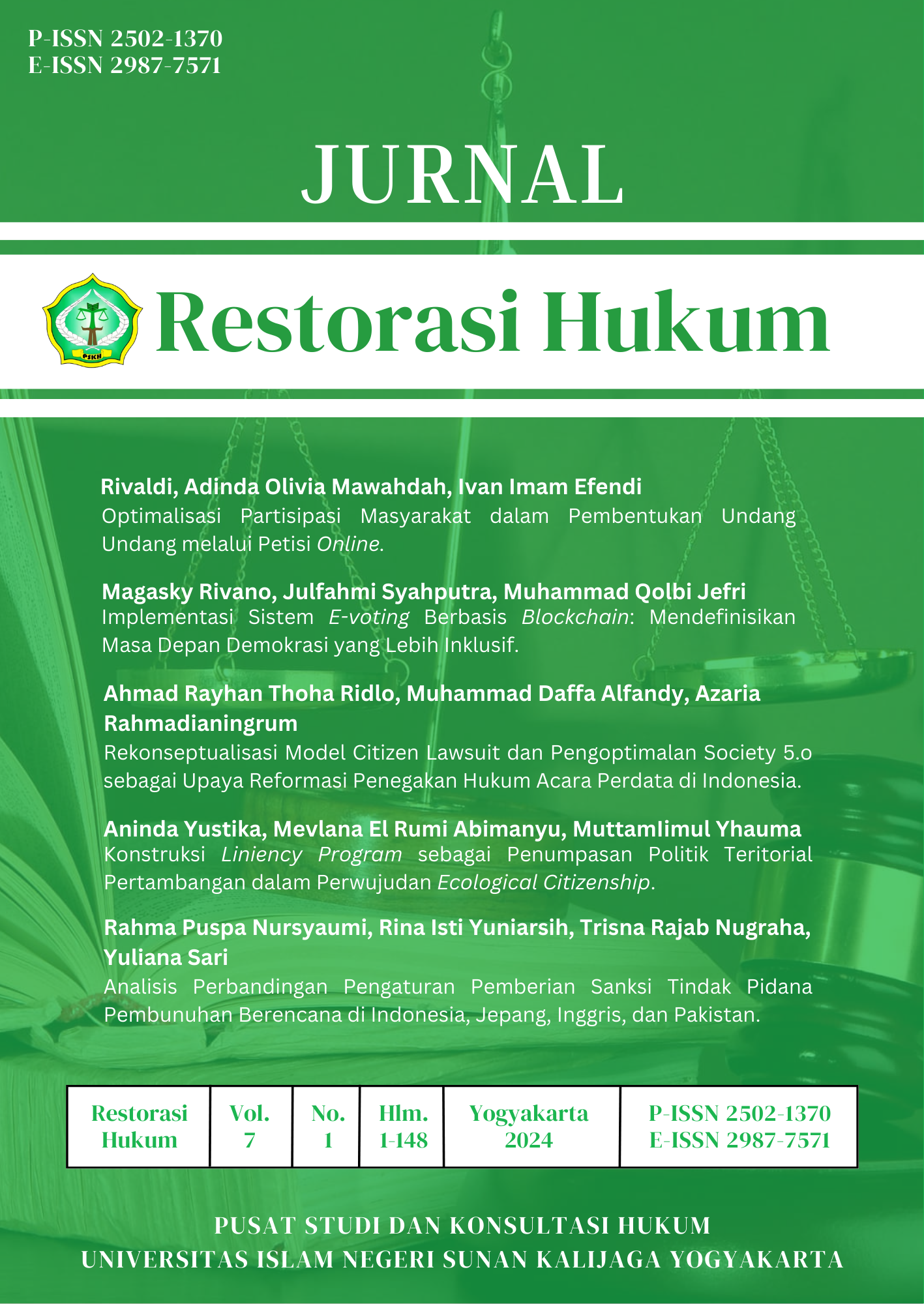Analisis Perbandingan Pengaturan Tindak Pidana Pembunuhan Berencana di Indonesia, Jepang, Inggris, dan Pakistan
DOI:
https://doi.org/10.14421/jrh.v7i1.3316Keywords:
Pembunuhan Berencana, Indonesia, Jepang, Inggris, PakistanAbstract
Abstract: This research examines how premeditated murder is punished in different countries. Legal systems (Continental European, Civil Law, Islamic) influence the severity of sentences, ranging from life imprisonment to death. The study compares punishments in Indonesia, Japan, England, and Pakistan. Indonesia allows the death penalty or life imprisonment, while Japan adds a minimum of five years to life sentences. England solely uses life imprisonment. Pakistan, under Islamic Law, offers the death penalty, Qisash (retribution), or Diyat (compensation) if the victim's family forgives.
Abstrak: Penelitian ini membahas bagaimana hukuman dijatuhkan pada pembunuhan berencana di berbagai negara. Sistem hukum (Eropa Kontinental, Hukum Sipil, Islam) mempengaruhi beratnya hukuman, yang bisa berupa penjara seumur hidup hingga hukuman mati. Penelitian ini membandingkan hukuman di Indonesia, Jepang, Inggris, dan Pakistan. Indonesia menerapkan hukuman mati atau penjara seumur hidup, sementara Jepang menambahkan minimal lima tahun untuk hukuman penjara seumur hidup. Inggris hanya menggunakan hukuman penjara seumur hidup. Pakistan, di bawah Hukum Islam, menawarkan hukuman mati, Qisas (pembalasan), atau Diyat (kompensasi) jika keluarga korban memaafkan.
Downloads
References
Ahmad, I. (2021). Islamic Punishment of Death as Qishas and its Execution in Pakistan. MA'ARIF-E-ISLAMI, 101-102. Retrieved from https://mei.alou.edu.pk
Ahmad, I., & Khan, A. (n.d.). Implementation of Islamized Law of Murder in Pakistan and Social Concerns on Acquittal of Murderers on the Basis of Islamic Concepts of ‘afw’ and ‘sulh’. UOCHJRS, ISSN: 2616-6496, Vol. 4 , Issue 2,, 2021. doi:DOI: 10.33195/journal.v4i02.226
Ahmad, I., & Khan, A. M. (2020). Compatibility of The Islamixed Law of Murder of Pakistan With Modern Jurisprudensi. Al-Aijaz Research Journal of Islamic Studies Humanities. Retrieved from https://doi.org/10.53575/E11.v4.01.121-12
Fatima, Fariha, & Shahzadi, P. (2022). Application of Islamic Legal Maxims to Qiṣāṣ and Diyat Crimes and Their Punishments. Peshawar Islamicus, Vol:13, Issue 2. doi:DOI:10.5281/zenodo.7494031
Hajed, A. (2021). The challenges of execution of Islamic criminal law in developing Muslim Countries: An analysis based on Islamic principles and existing legal system. Cogent Social Sciences, 7:1. doi:DOI: 10.1080/23311886.2021.1925413
Hashimoto, D. (1996). Japan and capital punishment. Human Affairs, Vol 6 Issue 1.
Hassanein, A. (2018). The Impact of Islamic criminal law on the Qatari Penal Code. Arab Law Quarterly, 32 (1). Retrieved from https://doi.org/10.1163/15730255- 12314037
Herrmann, J. (2001). The death penalty in Japan: An absurd punishment. Brook. L. Rev., 67, 827.
Iriyanto, Echwan, & Halif. (2021). Unsur Rencana Dalam Tindak Pidana Pembunuhan Berencana. Jurnal Yudisial 14, no. 1. Retrieved from https://doi.org/10.29123/jy.v14i1.402.
Munoz, A. (1964). Murder Rule- A Re- Examination, The Notes. Santa Clara Law Riview Volume 5 Number 2: Article 5 .
Pieter, Salvadoris, & Silambi, E. (2019). Pembuktian Dalam Tindak Pidana Pembunuhan Berencana Ditinjau Dari Kitab Udang-Undang Hukum Pidana.”. Jurnal Restorative Justice 3, no. 1. Retrieved from https://doi.org/10.35724/jrj.v3i1.1940.
Pitts, C. (2018). The death penalty in Japan: Will it lose its appeal? Journal of Kyoritsu Women's Junior College, .
Polizzi, C. (n.d.). The crime of terrorism: An analysis of criminal justice processes and accountability of minors recruited by the Islamic State of Iraq and Al-Sham. UC Davis Journal International Literature & Policy, 24, 1, 2017. Retrieved from https://heinonline.org/HOL/ LandingPage?handle=he
Pratiwi, Veronica, & Nursiti. (2018). Tindak Pidana Pembunuhan Berencana Yang Dilakukan Secara Bersama-Sama.”. Jurnal Ilmiah Mahasiswa 2, .
Saputra, & Prayudi, R. (2020). Perbandingan Hukum Pidana Indonesia Dengan Inggris. Jurnal Pahlawan Volume 3 Nomor 1. .
Sarwan, K. (2022). The Offence of Abetment Liable to Capital Punishment under the Islamic Criminal Law and the Pakistan Penal Code,. Al-Azhar:vol 8,Issue 1. doi:DOI: https://doi.org/10.46896/alazhr.v8i01.353
Shallom , J., Keren, & Karina, H. M. (2022). “Analisis Perbuatan Obstruction of Justice Yang Dilakukan Oleh Aparat Kepolisian Dalam Perkara Pembunuhan Berencana.”. Jurnal Esensi Hukum 4, No.2 .
Sutheland, E. H. (1925). Murder And The Death Penalty. Journal Of Criminal Law And Criminology.
Tongue, & Megan, E. (2015). Does The Punishment Fit The Crime? A Comparative Note On Sentencing Laws For Murder In England And Wales Vs The United States Of America. Missouri Law Revie Volume 80, Article 21.
Buku
Hamzah, A. (2022). Perbandingan Hukum Pidana di 18 Negara.” . Jakarta: Raja Grafindo Persada.
Lamintang, P., & Lamintang, T. (2012). Kejahatan Terhadap Nyawa.Tubuh, Dan Kesehatan. Jakarta: Sinar Grafika.
Roeslan, S. (1987). Stelsel Pidana Indonesia. Jakarta: Aksara Baru.
Karya Tulis Ilmiah
Prakoso, H. (2014). Perbandingan hukum mengenai tindak pidana kejahatan terhadap nyawa menurut KUHP Indonesia dengan KUHP Jepang. . SKRIPSI-2013.
Downloads
Published
Issue
Section
License
Copyright (c) 2024 Rahma Puspa Nursyaumi, Rina Isti Yuniarsih, Trisna Rajab Nugraha, Yuliana Sari

This work is licensed under a Creative Commons Attribution-ShareAlike 4.0 International License.
Authors who publish with this journal agree to the following terms:
- Authors retain copyright and grant the journal right of first publication with the work simultaneously licensed under a Creative Commons Attribution-ShareAlike 4.0 International (CC BY-SA 4.0) that allows others to share the work with an acknowledgment of the work's authorship and initial publication in this journal.
- Authors are able to enter into separate, additional contractual arrangements for the non-exclusive distribution of the journal's published version of the work (e.g., post it to an institutional repository or publish it in a book), with an acknowledgment of its initial publication, i.e. this journal.
- Authors also grant any third party the right to use the article freely as long as its integrity is maintained and its original authors, citation details, and publisher are identified.




